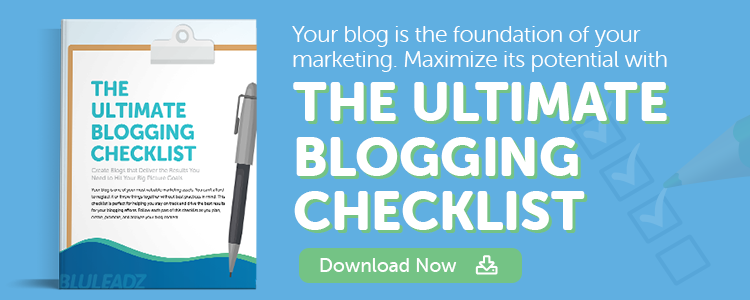When you’re looking to get started or continue building your marketing career, there’s one very important element you can’t overlook – your personal brand. Branding is an essential component in the marketing world.
So why not showcase your marketing skills by marketing yourself?
If you don’t have a personal branding strategy in place, you’re already falling behind. Your dream employers are looking for you, so show them why you’re an A player and how you can deliver value.
Employers are looking for your personal brand at every stage of the hiring process. But your brand is more than just tangible elements, like an awesome resume or an online portfolio.
Essentially, your personal brand is synonymous with your reputation. It's your overall messaging of who you are as a marketing professional, which is delivered through your online presence and your interactions with employers and your network.
Employers know what they want to see ... and what they don’t want to see.
There are three aspects you should focus on during the hiring process: your online presence (so employers find you), your application (to demonstrate your value you can bring to the prospective role), and your actions during and after an interview (to impress and further engage employers).
Let's take a look at what red flags you might be raising in each of these aspects (and what to do instead):
Your Online Presence
Talent acquisition managers are looking for you, even if you didn't apply or engage with their company. The war for talent is continually heating up, and your awesome skills and knowledge are needed now.
Your online presence is likely the first impression you make on hiring managers and employers – and your social media is a major component of your online presence.
Seven of 10 employers are using social media to screen candidates before they make a hiring decision, according to CareerBuilder's 2017 survey. They're looking for many things, including:
- Information that supports their qualifications for the job (61%).
- If the candidate has a professional online persona at all (50%).
- What other people are posting about the candidates (37%).
- For any reason at all not to hire a candidate (24%).
Make sure you're developing an authentic, engaging, professional online presence, which is one of your best personal brand assets. There are plenty of ways you can botch this first impression and hurt your chances for landing that next big career move.
Here are the red flags you want to avoid with your online presence:
1. Making Your Social Media Accounts Private
It's always important to practice good safety measures on the internet, but you don't want to be completely invisible. Employers are assessing your social media to learn more about who you are, both professionally and personally.
Tip: Showcase your personality by sharing posts that highlight your interests. But make sure you're not using the same strategy for each platform.
Your Facebook is best for personal interests, but you can share some of your professional interests as well.
Twitter is still a great platform for connecting and engaging with professionals in your industry. Use Twitter for sharing marketing industry insights and participating in informed conversations.
Obviously, your LinkedIn profile is your best social media asset for overall career management. Stay active in LinkedIn groups, spark conversations, and share your best work.
2. Failing to Use Profile Pictures

Employers view a faceless online presence with skepticism and disinterest, especially in marketing. Your profile pictures are one of the first things viewers see when they find you on social media.
If you're absent from your profile photos, employers don't get a good sense of who you are and might even question your credibility.
Would you ever buy products or use services from a company or brand that didn't present a human element? Probably not.
Tip: This is as common sense as they come: Invest in a professional headshot. There are plenty of budget friendly options.
You're putting a face to your personal brand, so make sure you dress in appropriate attire and use a plain background. This way, the backdrop isn't distracting from your awesome smile.
3. Sharing Inappropriate Content
This is another piece of common sense that many people fail to follow. You can have a raunchy, goofy sense of humor, but if that meme or video is NSFW, it's NGTP (not good to post).
Also, using profanity or making derogatory comments is a huge red flag. How you conduct yourself online says a lot about how you conduct yourself in person during social situations and your overall character.
Tip: Stay focused on sharing professional, PG-rated content. Before you share content, ask yourself a simple question – would you want your boss to see it?
And don't be jerk, plain and simple. Exercise the same civility online as you would at a professional networking event or in the office. If you disagree on a comment or certain post, share your perspective in a respectful way.
4. Lacking Original Content
Sharing your favorite thought leader's podcast or most recent blog is a great idea, especially if you provide some commentary on it. However, you don't want your feed filled with other people's work.
Tip: There's a simple cliche you should always keep in mind as you build your personal brand through your online presence: Show. Don't tell.
When employers are evaluating you, they're not just looking for what you know and what you like in the world of marketing. They want evidence of your skills and abilities.
The best way to provide evidence is by building a portfolio and sharing your best work to the world. Your online portfolio will yield dividends throughout the entire hiring process, so start now and continue building it as you advance through your marketing career.
Your Application
You put in all that time to research companies, find job postings, and submit your application. Then, you wait.
And wait. And wait. And wait some more.
Often, you never hear anything because when you apply, you disappear in a sea of potentially hundreds of applicants. It’s hard for you to stand out from the crowd.
Here are red flags to avoid as you submit applications:
5. Being Inconsistent With Your Resume and LinkedIn Profile
Many applications allow you to upload your resume along with a link to your LinkedIn profile. You can even download your LinkedIn profile as a PDF and submit it that way.
Even if you don't include your LinkedIn profile in your application, you can bet on employers checking your LinkedIn as they research you. If they see your LinkedIn profile is inconsistent with your resume, they might think you're being dishonest.
Plus, it hurts your credibility.
Tip: Remember, your resume and LinkedIn profile are some of your most valuable personal brand assets.
Update both your resume and your LinkedIn profile, and do it frequently. Before you submit your application, look at your profile and resume side by side. Ask yourself what experiences, skills, and certifications are relevant to the company and the role that you can include.
6. Not Submitting a Cover Letter
There's a lot of debate on whether or not cover letters are worth the time and effort. Bottom line: If you want the job, put in the time to share how you can be of value. If you don't write one, employers might think you don't really want the job.
Tip: Cover letters still matter to many employers and hiring managers. In fact, Jobvite's 2017 study found that 26% of recruiters still find value in cover letters.
Don't just regurgitate your resume in your cover letter. Use your cover letter as an opportunity to tell a concise story demonstrating your best skills and expertise.
Most importantly, be authentic and showcase your awesome personality. Your cover letter should align with your personal brand messaging so every element of your brand is both consistent and informative.
7. Sticking to the Boilerplate Approach
There are plenty of job application apps that allow you to use a one-click apply option. You simply start a profile within the job board, like Indeed, and add your resume. Then, you click "Apply" on any job posting that looks interesting and keep scrolling.
This is super convenient and allows you to apply to dozens of jobs in a short period of time. But there's a glaring issue with this approach – you're not tailoring your application to the specific job and employer.
Every application, including your resume and cover letter, should be distinct for each role you apply for. Otherwise, you're just one of the hundreds of other applicants who are one-click applying and moving on.
Tip: Do your homework and find how you can relate your experiences, skills, and knowledge to the company and the job you are applying for.
For example, if you are applying to be an SEO specialist, use your cover letter to tell a story of your best SEO campaign you conducted at a previous job. Share what problems you faced, where you made mistakes, how you adjusted, and what the results were.
8. Failing to Follow Up

Your application falls into the black hole of an applicant tracking system (ATS). So if you're just applying and waiting, you're going to wait forever.
This is where the art of the follow up can help you. If you send a follow-up email or LinkedIn message to the hiring manager, they can look you up in their ATS and assess your online presence.
Tip: Personalize your follow ups and inject some personality into them. A boring message that is simply requesting more information on the status of your application is a dime a dozen.
Your follow up actually serves a few purposes. Not only are you checking on where you are in the hiring process; you're also further demonstrating your value and emphasizing your personal brand messaging.
For example, in your email or LinkedIn message, don't just ask for an update. Include links to your online portfolio in your follow ups, or share a concise story showcasing your marketing expertise.
Your Interview
The interview is your time to shine! No pressure, but you only have a few minutes to really wow the interviewer.
CareerBuilder's 2018 survey found that almost half of employers know if a candidate is a good fit within the first five minutes. The survey also found the most common mistakes employers see in interviews, including the following:
- The candidate is caught lying (71%).
- They answer their phone or send a text during the interview (67%).
- They come off as arrogant or entitled (59%).
As you can see from these common mistakes, most issues arising during interviews violate basic etiquette. Here are a few other red flags you want to avoid in your interview:
9. Failing to Research the Company or Role
Interviewers want to see that you took the time to learn a bit about the organization, their values, their mission, their culture, and the prospective role. And why wouldn't you take the time?
You want to know for sure that you and the employer fit well. Plus, you should know how you're qualified for the opportunity so when they ask you questions, like what your strengths and weaknesses are, you're able to answer with informed, relevant information.
Also, when you bring questions to ask the interviewer, make sure they're not obviously answered on the company's website. For instance, don't ask what their core values are because they're likely published on their website.
Tip: There are plenty of resources you can use to research employers and the role you're interviewing for. Review the company's LinkedIn page, social media, Glassdoor, and the job posting.
Take notes on the most important information that will likely come up during the interview. You can also base the questions you ask off of this information. By thoroughly researching, you're demonstrating your attention to detail and thoroughness, which you should align your personal brand messaging around.
10. Demonstrating Poor Etiquette
Unfortunately, this is all too common. As CareerBuilder's survey found, there are several ways interviewees can come off as impolite and rude.
Dressing too casually, arriving late, and eating during the interview are just a few examples.
Tip: Professionalism is an important characteristic to showcase through your personal brand. After demonstrating your professionalism through your online presence, exhibit it in person during the interview.
Brush up on basic interview etiquette. The best way to determine what's appropriate is by stepping into the shoes of the interviewer. Think about how certain actions, like cursing or speaking negatively about previous employers, can be perceived as disrespectful.
11. Playing the Blame Game
During your interview, you'll likely be reflecting on past experiences with your employers and former teammates. And not all cultures and workplaces are perfect.
But when you adopt a victim mentality, blaming your circumstances or others around you for setbacks and failures, you're showing that you don't accept responsibility. And lacking personal accountability is not a good characteristic to showcase. It will tarnish your brand.
Tip: Strive to be honest and share your perception of certain experiences (including negative ones), but stop pointing fingers or passing the buck. Instead, take ownership of your missteps.
Failure is part of everyone's career and every business. And interviewers understand that. So embrace your mistakes and emphasize what you learned and how you grew.
12. Sticking to Canned Responses
Authenticity is so important when it comes to personal branding, and it's especially valuable during an interview. Remember, you're not trying to trick employers or be something you're not just to impress them. You're ensuring that you fit the role and the culture.
If you're just reciting what you think interviewers want to hear, you're not showcasing your true self. But that doesn't mean you shouldn't prepare beforehand.
Tip: Make authenticity a priority, and showcase your unique personality. Remember, they're not looking for scripted responses they hear from everyone else.
Instead, research the company and review common interview questions. Then, write out a list of talking points for each question. Talk through each point a few times by yourself or with your friends and family to practice.
When it comes time to shine, stick to your personal brand messaging in a genuine way.
By avoiding these 12 red flags through personal branding, not only are you ready to ace the hiring process and land your next marketing dream job; you're also laying the foundation to further develop and grow your personal brand as you advance your marketing career.


Jeff Previte
I am a Content Manager at Bluleadz. I enjoy spending time outdoors -- camping, hiking, hammocking, and everything in between. I also love reading, writing, and learning how to play guitar.